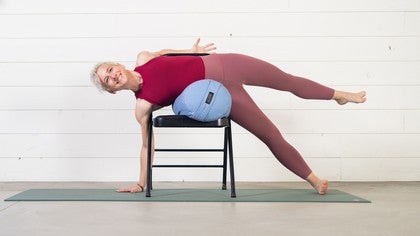
Gifts for Navigating Loss & Letting Go: One Yogini's Journey
"To be fully alive, fully human, and completely awake is to be continually thrown out of the nest. To live fully is to be always in no man's-land, to experience each moment as completely new and fresh. To live is to be willing to die over and over again."
~ Pema Chodron, When Things Fall Apart: Heart Advice for Difficult Times
Storytime
In Buddhist folklore, there lived a mother named Kisa Gotami whose son became sick and died. Amid her own disbelief and heartbreak, many thought that she had lost her mind. An older man who lived in her community told her to go to see the Buddha. The Buddha told her that he could bring the child back to life if she could find white mustard seeds from a family where no one had died. She travelled from house to house, and she could not find a house that had not experienced the loss of a family member.
At some point on her journey, Kisa Gotami awakened to the truth of suffering which the Buddha wanted her to see for herself – that no house, no family, no human, no relationship is free from loss, death, and the inevitable journey of letting go. Once this truth was realized, she returned to the Buddha and dedicated her life to her practice.
I remember reading and re-reading this story early in my own chapter with grief, when the tears flowed daily and simple acts like getting out of bed and walking my dog felt like more than I could handle. Sharing and listening to real-life stories is such a beautiful way to connect and feel less alone as we digest the extra-ordinary pain of being human.
I also clearly remember some of the ways my yoga showed up for me, in ways I could have never imagined, and I want to share some of these observations with you here. It is my hope that your real-life yoga can show up for you, too, when you need it the most.
The gift of embodiment practices
When grief came knocking at my door in 2011, I had been practicing yoga consistently for almost 15 years. In some ways, everything changed during that short time which felt like forever. And, in other ways, the familiarity of practice showed up for me and held my hand through some of the loneliest days. I learned that it truly didn't matter the specific techniques for what I was doing, but it did matter that I oriented to the sensation of myself breathing and allowed time and space to move and be moved.
Breathe in. Inner body leans into outer body. I feel myself breathing in.
Breathe out. Outer body leans into inner body. I feel myself breathing out.
Feel my body touching solid ground.
Feel my skin touching the sky.
Notice.
From these simple cues, which helped me to land inside of moments, some days I'd simply lie on my mat and be still (or cry). Other days, I would flow creatively through a movement dialogue which swallowed my sadness temporarily and reminded me of the gifts of sensation and being alive. I learned to have fewer expectations about what my so-called yoga looked like, and to trust more in the process of showing up for whatever is real in the moment.
Letting opposites breathe you
Sutra 2.48 of Patanjali's Yoga Sutras is a poetic line which asks the yogi to consider holding the truth of opposites within a single moment of awareness, breathing, and/or truth.
Tato-dvandva-an-abighatah
Translation: "Thereafter, one is undisturbed by the dualities of opposites."
This sutra is often translated in the context of asana through cues like "lean down and rise up" or "finding a balance of ease and vitality within your posture". However, within the context of our emotional journey of grief, we can practice bringing moments of wonder and simple joy into our days as a strategy for breathing space into the sadness, fear, and loneliness we may feel. I remember the potency of noticing the magnificence of the sunshine sparkling through the forest, and the tears of joy when I made eye contact with a stranger during some of my darkest days. Below are a few words I wrote in my journal in the months after the death of my first-born son in 2011:
Amidst so many moments of sadness
There are jewels of joy,
Intense deep love,
Immediacy,
Eye contact – and then stillness.
My own dance with grief asked me to experience and even celebrate the opposites within myself as part of the bigger whole. Ultimately, death and life together have the potential to awaken us to the true nature of this lifetime and the inevitable uncertainty of each moment. It is my hope that we practice together playfully with a willingness "to experience each moment as completely new and fresh".
Gratitude
To close, I would like to share with you a simple practice of gratitude, which can be incorporated into your formal yoga asana practice and as a moment of connection in your day.
First, I welcome you to notice 3 things that are happening right now, which you are grateful for. Take a few moments to let these three things emerge and ensure they are happening in the present moment.
I am grateful for the roof over my head.
I am grateful for my beating heart.
I am grateful for the sensation of my soft sweater on my skin.
Once you have your three things, repeat them in your head a number of times. As you repeat them, feel them through the cells of your body and consider the possibility of bathing in the sensation of gratitude with your skin, bones, nervous system, breath. Can you feel it?
To close this simple practice, bring your palms together in the gesture of gratitude, which is sometimes called Yoga Mudra. Hold the sensation of gratitude in the palm of your hands, and then bring your hands to touch the ground. May we plant seeds of yoga through the gesture of our palms touching the ground as a way to share the gifts of our presence and yoga with all beings everywhere.
Join Sarah on your mat for Season 2 of Wake Up with Yoga, on Yoga Anytime.
Comments

You need to be a subscriber to post a comment.
Please Log In or Create an Account to start your free trial.








